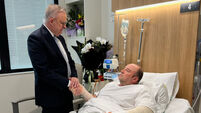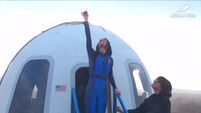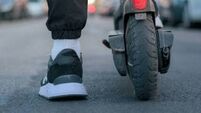Missiles and stealth fighter-bombers open war
The opening salvos in the war to remove Iraqi President Saddam Hussein relied on tried-and-tested cruise missiles and precision-guided bombs dropped by US Air Force stealth fighter-bombers.
The munitions were aimed directly at the country’s leaders, including Saddam, American officials said.
The attacks involved more than 40 Tomahawk cruise missiles launched from US Navy ships in the Persian Gulf and the Red Sea, as well as bombs dropped from two F-117A Nighthawk stealth jets, military officials said.
The Nighthawks each dropped two 2,000lb bombs called Joint Direct Attack Munitions, which are guided by satellite signals.
Two officials close to the operation said the Iraqi dictator was among the “leadership targets” that the strikes were aimed at.
The bombs dropped by the planes are each twice as big as the sea-launched cruise missiles also dropped overnight. The F-117s are based at Qatar’s Al Udeid air base.
Military officials said the Tomahawks were fired by the destroyers USS Milius and USS Donald Cook the cruisers USS Bunker Hill and USS Cowpens and the attack submarines USS Montpelier and USS Cheyenne.
US officials said the attacks were not a sign that the main air offensive against Iraq had begun.
Rather, they were approved by US President George Bush in response to time-sensitive intelligence on the whereabouts of Iraqi leaders - presumably including Saddam.
Officials said it was possible that other limited attacks in various parts of Iraq could be launched over the next day, even before the main air assault begins.
Three of the Tomahawks were launched from the USS Donald Cook, a destroyer in the Red Sea.
The US Navy released still photos and video of the missiles being launched just hours after the attack.
Introduced during the war with Iraq a dozen years ago, the Tomahawk is still a technological wonder, able to fly at just under the speed of sound, hugging the ground to deliver a 1,000lb warhead onto a pre-programmed target.
The US Navy probably has about 1,000 Tomahawks.
Radar detection of the missile is extremely difficult because of the small radar cross-section and low-altitude flight profile.
A next-generation Tomahawk adds the capability to reprogramme the missile while in-flight to strike any of 15 pre-programmed alternate targets.
The F-117A Nighthawk, the distinctive fighter-bomber that looks like a bat, is the world’s first operational aircraft designed to exploit stealth technology that makes it difficult to detect with radar.
In the Gulf War a dozen years ago, the Nighthawk was the only US or coalition aircraft to strike targets in central Baghdad.
The F-117A programme created a revolution in military warfare by incorporating low-observable technology into operational aircraft.
Before last night’s strike, a senior US Air Force planner said American war planes are likely to drop 10 times as many precision-guided bombs on the first day of a war against Iraq as they did to open the 1991 Gulf war.
“I don’t think the potential adversary has any idea what’s coming,” said Colonel Gary Crowder, the chief of strategy at Air Combat Command, which is responsible for all US Air Force war planes.
At the Pentagon, Crowder said 300-400 precision-guided weapons were dropped on the first day of the 1991 air war and suggested at least 3,000 would be used on the first day this time.
War planning has also become much more efficient, Crowder said. In the first Gulf war, US war planes attacked each element of Iraq’s air defences in sequence - early warning radars, followed by air defence operations bunkers, followed by airfields and surface-to-air missile sites – before getting to the ultimate target: the Iraqi leadership.
This time, due to more accurate weapons and a better understanding of targets in Iraq, the leadership will be attacked at the same time that communications, transportation and air defence targets are bombed, Crowder said. Examples of leadership targets are palaces and command centres expected to be used by Saddam and his senior generals.
This more efficient approach is based in part on improved weapons technology and more advanced means of matching weapon types with the kinds of damage desired, Crowder said.
For example, if the goal was paralysis of the Iraqi electrical grid, the war planners might single out a small number of power stations or transmission towers as targets rather than striking every power station in the grid.
Crowder also said that the experience gained from patrolling “no fly” zones over southern and northern Iraq since shortly after the first Gulf war gives American and British forces a big advantage.
“Having lived over the no fly zones for the last 12 years, it is a significantly less hostile place than it was in northern and southern Iraq on the opening night of the (1991) Gulf war,” he said.
“That simple fact will make the jobs of our men and women aircrews out there doing this a whole lot easier,” he added.
The routine of patrolling the zones also provides a form of cover for allied aircraft preparing to launch an all-out air war.
Earlier yesterday, US and British jets attacked nine military targets in southern Iraq.
The headquarters for allied air forces in the Persian Gulf announced that the strikes were in response to Iraqi anti-aircraft artillery.
The targets included long-range artillery near the southern city of Basra and the nearby Al Faw peninsula near the Gulf coastline, plus three military communications sites.
Also targeted was a mobile early-warning radar and an air defence command and control site at the H-3 airfield complex in western Iraq near the Jordanian border.
US aircraft also dropped nearly two million leaflets over southern Iraq with a variety of messages, including, for the first time, instructions to Iraqi troops on how to capitulate to avoid being killed.













